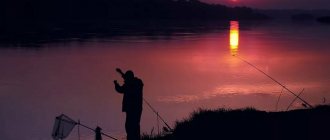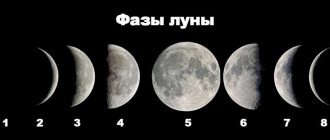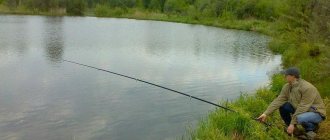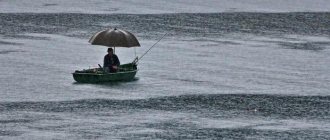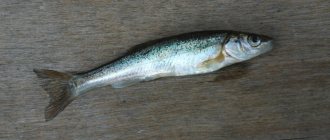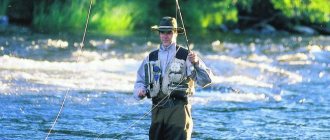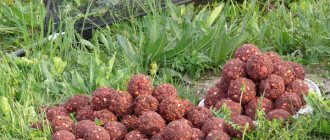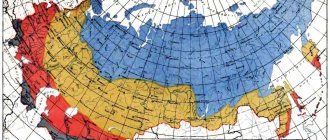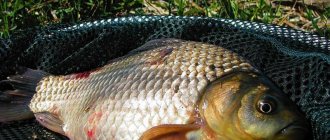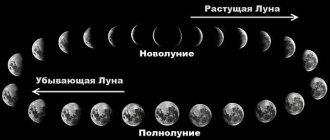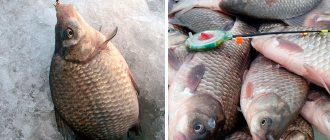Does crucian carp like rainy weather?
A good fisherman knows that fish are weather-sensitive creatures. The most unpleasant thing for them is a sharp change in atmospheric pressure; it is for this reason that a strong wind, which brings with it such changes, is an obstacle during fishing. Before rain, especially thunderstorms, the pressure changes, the air becomes “heavier”, the amount of oxygen in the air and water drops, which causes a feeling of discomfort in all living beings, including the inhabitants of water bodies.
In the pre-storm period, crucian carp can begin to peck very actively, but this phenomenon is due to the fact that the fish, sensing the approach of bad weather, instinctively tries to “refuel” well in order to then hide for a long time in the bottom thickets and wait out the unfavorable time. After the first drops fall to the ground, the pressure gradually stabilizes, which is why rain falling for some time usually does not interfere with fishing.
Important! Before the rain, as well as during a heavy downpour, the crucian carp practically does not bite. Many fishermen are even able to determine with high accuracy when bad weather will begin by the moment the bites stop.
The revitalization created on the surface of the water by drops of warm rain attracts fish to the upper layers of the reservoir, which mistake the circles diverging in all directions for small insects and actively rush to hunt. Fishing in the rain has one more pleasant feature: at this time the chance of catching a larger trophy increases than a small one, which is still frightened by excessive movement, and prefers to wait until the weather improves.

A cloudy day with a sluggish drizzle is not an obstacle to hunting crucian carp. However, the features of fishing in such weather still largely depend on the time of year, as well as the fishing location.
Thus, in July or August, the rainy period, as a rule, is replaced by a time of long and exhausting heat and is accompanied by the enrichment of stagnant water with oxygen. Under such conditions, the bite becomes more stable than under clear skies. In autumn and spring, when precipitation, on the contrary, brings with it a cold snap, the fish's appetite drops and fishing becomes unproductive. If the weather in the off-season is calm, and only from time to time the sky is covered with rain clouds breaking through with drizzling moisture, such rains have practically no effect on the bite.
Did you know? Psychologists made an interesting observation: when depicting a fish, when the species does not matter, 99% of artists subconsciously draw crucian carp.
Another reason for the deterioration of the bite during rainstorms is muddy water. In the absence of visibility, non-predatory inhabitants of reservoirs, which includes crucian carp, try to stay in shelters. Therefore, in shallow water, heavy and prolonged rain is a bad ally for the fisherman.
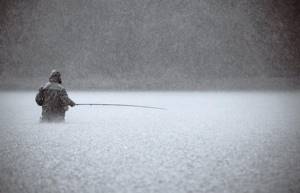
- The beneficial effects of rain on fishing:
- saturation of water with oxygen due to drops enriched with air falling into the water;
- cooling after the summer heat;
- ionization of water by differently charged particles, which occurs during a thunderstorm and has an invigorating effect on fish;
- washing into the reservoir a large amount of additional food - insects, including flying, ground and soil insects, their larvae, plants, food waste left on the shore by people, animal excrement (many fish feed on such organic matter);
- ripples on the surface of the water, masking the presence of a fisherman and creating an illusory sense of security in the fish.
- Negative aspects of heavy rainfall, from the point of view of crucian carp fishing productivity:
- atmospheric pressure surges;
- an increase in water level and a decrease in its transparency.
Secrets of catching crucian carp
Crucian carp is a finicky and unpredictable fish. A bait that gave an excellent catch today may not be needed tomorrow. Catching crucian carp is comparable to solving a rebus; if you guessed correctly with the catch, if you didn’t guess correctly, you came home empty. In order not to depend on chance, you need to know the secrets of successful crucian carp fishing:
- Know the features of the pond and its inhabitants. Small reservoirs up to 1 meter deep, habitat only for crucian carp. Other types of fish do not survive in winter. Deep reservoirs, over 2 meters, are the habitat of various types of fish.
- Know the signs by which you can determine the feeding location of a school of crucian carp. Air bubbles coming from the bottom and a characteristic slurping sound are a sure sign that crucian carp are grazing here.
- Listen to the weather forecast. Hot, persistent weather with high pressure will not bring good catches.
- Equipment. Crucian carp does not like heavy equipment. Feeling the heaviness of the nozzle, he spits it out and does not approach again. A float fishing rod should have a sinker of up to 5 grams, a donka should not have a sinker.
- Lure. Crucian carp is a substance abuser. He loves various pungent smells; he uses them to find food. Groundbait soaked in kerosene brings good results.
- Nozzle. You cannot go after crucian carp with a limited type of bait. The more varieties there are, the greater the chances of success. The bait should have the same smell as the bait.
- Crucian carp does not like clean, clear water. If the water in the place where you are fishing is like this, you need to use some available means to lift the turbidity from the bottom of the reservoir.
- Masking and keeping quiet. You shouldn’t wear bright jackets when fishing, park your vehicle near the shore and start it periodically. Crucian carp sees and hears well if fishing is close to the shore.
Compliance with these simple rules will not leave the fisherman without a catch.
Can crucian carp be caught after rain?
Once the rainfall has ended, it is the perfect time to go fishing. This is explained simply, because all the positive aspects that the rain brought with it are still in effect, but the effect of the negative ones, on the contrary, ceases. If the bad weather lasted for a long time, and the fish managed to get hungry, it will attack the long-awaited food with even greater activity and, accordingly, will be caught perfectly.

Atmosphere pressure
For a good catch, you will have to refer to the barometer readings. With a sharp increase in atmospheric pressure, crucian carp feel uncomfortable at the bottom, where they actually feed. After all, the density of water increases, an additional load is placed on the swim bladder, so the fish moves to the upper layers.
By the way, with a significant increase in pressure, there is often still calm, which does not create waves and does not mix air and water masses. There is less oxygen and the crucian carp now definitely have no time for food. They, on the contrary, simply stand at depth, and all their life processes, including digestion, are temporarily slowed down.
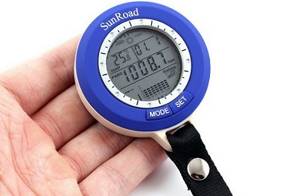
Strong surges in atmospheric pressure negatively affect the bite of crucian carp
A sharp drop in air pressure will have an even more negative impact on the bite than an upward barometer needle. The fish simply does not have time to change lanes and does not feel well the water level, depth, and even gets confused in the direction of movement. The crucian carp likes the slow decrease in atmospheric pressure.
Firstly, this is an undoubted symptom of deteriorating weather and the fish is trying to eat for future use. Secondly, there is also a biological explanation. It is necessary to compensate for the difference in pressure in the swim bladder and outside, so the crucian carp needs to feed intensively and stay close to the bottom, where the bait is waiting for it.
You will not be left without a catch even if the atmospheric pressure has been stable over the past 2-3 days. After and before spawning it is enough, even if there was no growth during the day.
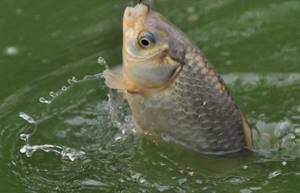
The best catch will be at stable atmospheric pressure
For fish living in reservoirs in mountainous areas, fluctuations in atmospheric pressure have practically no effect. You can catch it without looking at the barometer readings.
Tackle for catching crucian carp in the rain and after it
You can catch crucian carp with both a float rod and bottom tackle. The first option is considered preferable for summer time, the second - for winter and off-season.
However, fishing in rainy weather has its own peculiarities. When large drops, especially in combination with strong winds, create strong ripples on the surface of the water, using a float rod becomes almost impossible. And the problem is not only that the constant dance of the float on the wave does not allow you to notice the bite in time and hook it.
Find out also how to catch crucian carp in windy weather.
The disturbance on the surface of the reservoir sets in motion not only the float, but also the hook associated with it, on which the bait is attached. As a result, instead of smooth and measured movements, the fish sees an unnaturally twitching object in front of it, which bears little resemblance to something that can be tasted without risk to oneself.
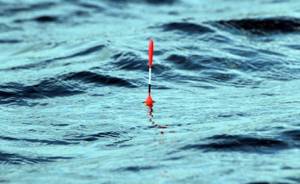
That is why, if on a calm and windless day, which comes after a heavy downpour, you can use any gear suitable for this fish to catch crucian carp, then directly during the rain, bottom variants of fishing equipment are much better suited - hooks, elastic bands, feeders, pickers, "springs" ", makushatniks, etc.
Crucian bite in summer
Summer is the period when crucian carp behave most predictably. What weather does crucian carp bite in summer? At this time of year, crucian carp primarily needs stable weather. Does not tolerate extreme heat and periods of sudden cold weather. Ideal weather for catching crucian carp in summer is with stable pressure around 765 mm Hg, light wind and air temperature ranging from 18 to 25 degrees Celsius.
- Water temperature. During periods when the water in the reservoir warms up above 25 degrees, crucian carp leaves their usual feeding areas and looks for areas with cool water. It is possible to catch it in such conditions in traditional parking areas, but the effectiveness of such fishing will be low. During periods of cold weather, when a cold wind or drizzling cold rain drops the temperature below +18, crucian carp begins to look for food in warmer areas. This fish does not tolerate sudden changes in temperature. The intensity of the bite is reduced to a minimum, or the crucian carp does not bite at all.
- Atmospheric pressure. Any sudden changes in pressure in the summer completely block the bite of crucian carp. At this time of year, crucian carp bite better at low pressure.
- Direction of the wind. In summer there is no direct relationship between the direction of the wind and the bite force of crucian carp. It all depends on what change in air temperature follows the change in wind. If the wind brings warmth after cold days, the bite will intensify. If in the summer the heat due to the wind is replaced by relatively cool weather, the crucian bite will also intensify. wintering. The bite intensifies on warm days and weakens during periods of cold weather. By frost, crucian carp stops actively pecking.
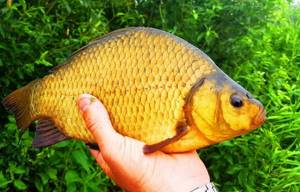
Weather factors that can affect crucian fishing at this time of year.
- Air temperature. A normal bite of autumn crucian carp is possible until the daytime temperature drops below + 15 degrees. As soon as the water begins to cool, the crucian carp will go to depths where the water still retains heat. During periods of warming, crucian carp actively feed; any cold snap completely interrupts the bite of this fish.
- Atmosphere pressure. Karas remains true to himself. Strong changes completely stop the bite. Small, gradual changes in pressure, which lead to an increase in air temperature, contribute to increased bite of crucian carp.
- Direction of the wind. The trend continues. A strong wind does not contribute to the bite. A weak westerly or south wind usually leads to increased bite. Wind from the north or east keeps the bite to a minimum. In autumn, the weather rarely pleases crucian carp with warm days.
At this time of year, crucian carp bite best in warm, windless weather with a clear, cloudless sky.
Accordingly, the bite of this fish with the approach of cold weather, regardless of the weather, gradually weakens and stops completely. Catching crucian carp in the fall, regardless of the weather, becomes a difficult task.
Note that large crucian carp generally do not like any sudden changes in weather conditions. Even with gradual changes in the weather, large crucian carp bite poorly. A sharp change in any weather conditions at any time of the year leads to a complete cessation of biting. On such days, fishing for crucian carp is unlikely to be successful.
Features of choosing bait and bait for crucian carp
After prolonged rains, during which river inhabitants had to sit out for a long time in bottom holes and other secluded corners of the reservoir, there is often not only a significant increase in the fish’s appetite, but also a certain change in its food preferences. Thus, omnivorous representatives of the carp family, namely crucian carp, prefer animal food, which is more caloric and nutritious, to plant food during this period.
Important! It has been noticed that precisely after long rains, episodes of cannibalism sharply increase among freshwater fish, when larger individuals devour not only fry, but even adult counterparts that are smaller in size.
A similar situation with changes in diet is typical for the cold season, when, with a decrease in water temperature, metabolic processes in the body of cold-blooded inhabitants of rivers and lakes slow down, and plant food is absorbed by fish for too long to lead to saturation.
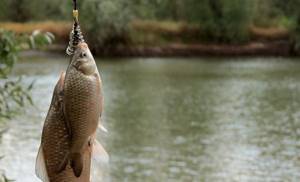
For this reason, the best bait for crucian carp during and after rains, especially cold and prolonged ones, are:
- maggot;
- bloodworm;
- tubifex;
- larvae of dragonflies or chafers, as well as fragments of adults of these insects;
- worms - earthworms, earthworms, dung worms, crawling worms;
- bark beetle;
- small insects (mayflies, etc.);
- chopped parts of fish, preferably caught in the same body of water.
Here you can read about the characteristics and fishing of silver crucian carp.
However, it’s also a good idea to have plant-based attachments on hand. Pearl barley, corn, semolina, millet, bread crumb, dough, and boiled peas are well suited for this purpose.

The size of the bait can be used to regulate the size of the potential trophy, cutting off the bite of prey that is too small. So, for example, bloodworms are a desirable delicacy for any fish, but before a larger, and therefore more experienced and cautious individual has time to get close to such bait, it will be pecked by more frisky fry. From this point of view, it is more effective to use maggots or corn kernels.
Did you know? Crucian carp can be attracted by such dubious, from the point of view of nutritional value, smells as valerian and corvalol. But the most surprising thing is that even kerosene acts as a flavoring agent for this unpredictable fish.
The success of fishing for greedy crucian carp also largely depends on the bait of the place. For this purpose, you can use ready-made store baits (for example, Marcel Van Den Eynde Feeder, Fish.ka, Traper secret, etc.), to which manufacturers add various pheromones and other bite activators. But such products, despite all their effectiveness, are too expensive to spend on catching such unpresentable fish as ordinary crucian carp.
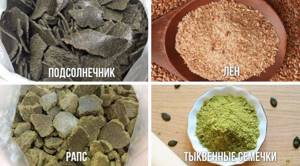
As a worthy alternative, you can use the cakes of various oilseed crops (sunflower, flax, rapeseed, pumpkin seeds, etc.), to which boiled porridge, bran, peas or breadcrumbs are added for stickiness, and herbs and spices for additional flavoring, for example, crushed seeds of dill, coriander, cumin, crushed garlic, anise, vanilla.
Important! In the cold season, crucian carp react more actively to strong and pungent odors, in particular garlic, and in the summer the fish prefer sweet aromas - vanilla, chocolate, cinnamon.
After heavy rain, artificial bait at the future fishing spot can be replaced with natural bait, skillfully using the advantages given to the fisherman by nature itself. Thus, the maximum amount of all kinds of food, washed away by the flow of water from the surface of the earth or knocked out from coastal areas of soil, is collected at the bottom in deep holes, backwaters behind a cape surrounded by a current, and other quiet areas.
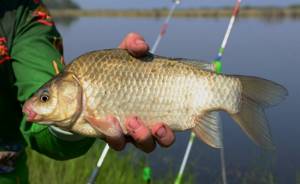
This is where a school of hungry fish will most likely head, which means this is where it makes sense to set up for fishing. At the same time, it is not at all necessary to throw the tackle to the very bottom - active crucian carp, having gathered at the “feeder”, can circle around in different planes, so any appetizing bait, even thrown to a shallow depth, will not go unnoticed.
Bait and bite
The activity of fish is greatly influenced by the natural conditions of the reservoir in which it lives. The degree of warming of the river and lake, and, consequently, the appearance of fresh algae and worms, as well as other components from the diet of crucian carp, depends on its depth. Weather conditions also play a significant role. It is the appearance of food in sufficient quantities that forces the fish to come out of hibernation.
The same thing began gradually. The small pay lines are full of repeatedly killed carp that bite very, very hard! Even in the very early spring, immediately after the ice melts, carp are activated, but they have a very low metabolism, are easy to feed and incredibly scary. After the calmness under the ice, on the shore there is boom, balls, corn and so on! It is normal for carp to rise in the middle of the pond and not dare to approach the shore. Perhaps some fish lie near the shore early in the morning or at dusk.
Classical point of view
The easiest fishing is the feeder. It is thrown far inwards and often the carp will be caught on their own when the glue is properly constructed, i.e. not too rough. If the day is relatively calm and there is no strong wind, you will catch a lot of fish, but the fishing is somewhat logical. A much smarter option is to use fine-tuned matching. When there is a race and the fishing is clearly indicated to be in the know, it is clear that it should be caught as a match, but when you are free fishing, the game is sometimes the easiest and most effective way to catch fish.
The fish needs to regain its strength as quickly as possible, because it needs to be in time before spawning begins. This means that the crucian carp has only 2-3 weeks. Therefore, with the first warm days in March, the fish already begin to actively obtain food for themselves.
Crucian carp spawning
The main fiber should not have a cross-section higher than 0.16 mm, and the reason should not be more than 0.14 mm. The hook is chosen against the bait. Power supply The most important point here. No typical carp foods are recommended. Typically, those who catch the most don't use bait at all! They only feed on clay with a feathered worm or a very large amount of whitefish and some fish pellets here and there. The same applies to the catch. Then it can be beaten, but measured again.
Which type of crucian carp starts biting earlier?
A very important condition for carp fishing is that the bait lies on the bottom. If a hook with bait is rolling somewhere in the water, it is unlikely to catch a carp. Another important success factor is the choice of location. In icy water, fish are not very mobile, and you need to know where they are holding in a given water at a given time of day. The next factor is patience. It does not say that there will be dynamic fishing in the first hour. You don't get lunch until midday, but in the afternoon, after the gentle spring sunshine, the fish move in and do some great fishing.
The breeding season for fish begins in April, as soon as the water warms up to the required temperature. In the northern or eastern regions of our country, the necessary conditions may appear only in May. Crucian carp that have reached the age of 4 years take part in spawning.
This process itself is gradual and lasts for two weeks. At one time, the female lays 150 thousand eggs, and most of them usually go to feed other fish. In total, she makes an average of 5 visits.
The fish is now weak and very, very capricious. Bait Traditional carp hunt for corn, but this is no longer the best bait. The choice of bait depends on how much we feed. If we use crushed fertilizer with clay and we catch a wild worm, there will be some stick there, but when we add two white worms or corn to the hook, the bite will be more frequent and sharper.
The crucian carp is completely devoted to the process and does not bite at all during this period. After a month, the female can already repeat spawning, if weather conditions allow, and more than once. Therefore, this process may drag on until early July.
Spawning sites are chosen where there are dams or spills. Lake representatives settle closer to the shores. After this process is completed, the crucian carp returns to its original habitat.
It also happens: How to catch crayfish: several ways
Secrets of catching crucian carp
For this reason, competitors, for example, fish with squirrels, but hunt for patterns. If a lot of corn or wheat is burned and caught by corn with a white worm, the bill will likely be larger. Now, in icy water, the carp chew the bait exclusively from below and are unlikely to be harmed by the continuous shooting of pellets, worms or corn. Last but not least, patience. If we don't have a pickup within an hour, it doesn't mean we have the wrong tactics, but we're probably not in the right place.
When does crucian carp bite better?
There have been several spring fire competitions recently, and the winners have invariably moved inside and haven't caught up with the power supply. It is considered by many fishermen to be one of the best months for hunting big carp. It has several favorable circumstances. The water temperature begins to rise significantly. Thanks to this, the carp begins to move quickly and feed. Slowly they begin to shake. They stick to areas that experienced fishermen are familiar with. Additionally, many fish can catch at their highest weight during this time.
Interestingly, in the absence of a male individual, a female crucian carp can spawn with other representatives of the cyprinid family. The released eggs are not completely fertilized and only females are born.
As noted earlier, spawning of crucian carp occurs when the optimal water temperature is reached. For different types of fish, these numbers may not be the same. For example, marks of 13° are sufficient for silver crucian carp. But the golden “brother” prefers warmer water at 17°.
When it starts to peck
So how do you manage this during this time? The first is to choose a location or find the area you want. In May, fish rarely spill out all over the water. They usually group in smaller or larger schools in certain areas and you just have to find them. To identify them, you need to know the weather and the approximate water temperature. The difference is whether the water is still cold and the cool wind from the north has been warm for a few days, or if it is warm enough and a stable sunny day. Carp are very sensitive to these fluctuations.
Air temperature
Especially in spring, this fundamentally affects not only their habitat, but also their desire to feed. In the warm variety, carp are likely to prefer shallow, warmer areas such as areas around reed fields, islands and underwater ridges or near shores if there is peace. Somewhere they will be deep in the subway, otherwise they will feel better at two to four meters. However, as they cool more, they will be drawn to deeper areas with more stable water temperatures. They don't say it all over the lake, but somewhere nearby, where they find the right temperature, enough oxygen, food and peace.
You can go fishing for crucian carp in the spring when the air temperature is above 10°, which lasts for some time. A small pond will warm up within 4 days. For larger rivers or lakes, you should wait a little longer. Fishing begins where there is a muddy bottom.
There is also no clear answer here. It has been noted that good fishing begins at dawn, that is, around 6-8 o’clock in the morning. She can then be active all day if it is cloudy outside. In sunny weather, the crucian carp goes closer to the bottom. In the pre-sunset hour, a good bite is also noticed among these individuals.
It's just that calm is an often underrated factor that fishermen forget. In an area where the carp can move without being disturbed, they have a much better chance of success than where there is someone constantly on the shore, where boats pass, they feed at feeders, etc. carp, sometimes resting, prefer it even if there is not enough food here. Behind her they go to busier places, often until night time when there is peace.
The moment you choose a spot to catch, you need to match them well. It's ideal if you know them from a previous hunt. Otherwise, you need to sit on the boat and go out on the water with a fish finder. Where not permitted, there is no need to use mapped floods or survey and target udder fisheries. There are also places that are so obvious that they don't require any major mapping, such as stump fields, banks of visible sandbars, island fields, Just think and be precise.
- The optimal spring temperature is approximately 10–15 °C. If it decreases, the crucian carp becomes inactive and lethargic, while hibernating. When warmth appears, the bite resumes.
- Windy weather has a good effect on fishing, especially if it blows from the south or west. Sometimes it’s good to fish in other wind directions. But at the same time, there should be no surges in atmospheric pressure, which have a bad effect on freshwater individuals.
- Cloud cover can also significantly reduce the number of fish caught. On clear and sunny days, the reservoir warms up better and only then does the crucian carp begin to actively search for food. The fish behave differently not because of the presence of clouds, but due to a change in the same air pressure.
A simple question, but a complex answer. If you over bait and the fish don't have any crap, you will make it look like you won't get enough when the fish are active and hungry. Sometimes the situation is so obvious that there is no need to wait. Capers are popping up and fishermen around are doing well.
But at other times it is not something to be caught, then it is better to start with caution, and if it turns out that now is the right time and that the shots are even more taunting, then increase the benefits. The amount of bait depends on the size of the field and its inhabitants. On small water, 0.5 to 1 kg per day may be enough, even when the fish are feeding intensively; on a large lake or river, it can be from 1 to 2 kg, just spitting into the sea. Of course, it is clear that many cannot afford to chew several kilograms of quality more expensive than boiling water per day.
It also happens: How to catch grass carp - what gear, lures and baits, video
Do fish bite in the rain: fishing features, signs
Over the centuries, signs have formed about the connection between the catch and the weather. It is believed that the wetter the fishing, the better the fishing. This activity will be good in cloudy weather and drizzling rain, but in bright sun fishing will be useless. During the dry season, it is better to fish at dawn or sunset.
The phase of the moon also affects: with a new moon there will be a good bite, and with a full moon there will be a weak bite. Fishermen have noticed that an active increase or decrease in air and water temperatures will not lead to a good catch. And if the water warms up gradually, then the time will be right. Whether fish bite after rain and thunderstorms depends on many factors, the main ones being weather conditions.
Do fish bite in the rain: fishing features, signs
Finally, you managed to find some time for fishing, now you have already half realized your dreams and reached your cherished place.
And it so happened that besides crucian carp, nothing else lives in the reservoir, and even after all your attempts to “persuade” it to bite, it does not give in. Let’s try to figure out what you need to know and do to avoid getting into such a situation.
Why doesn't the crucian carp bite?
Crucian carp, like most fish of the carp family, lacking a stomach, is forced to eat more often than other types of fish.
The fish adheres to the principle of little by little and more often, but even such a particularly unpretentious fish is characterized by interruptions in feeding.
The reasons for the lack of bite of crucian carp include:
- air temperature less than eight degrees or more than 270C (weather conditions, changes in atmospheric pressure);
- spawning period;
- inappropriate time of day;
- the fishing area is incorrectly selected (bottom topography, vegetation, current);
- plentiful food supply and lack of competition (the fish are simply always full);
- noisy environment on the shore of the reservoir;
- water condition (water bloom period);
- the bait is incorrectly selected;
- a sharp drop in water level in a reservoir;
- the composition and quantity of complementary foods is incorrectly selected;
- the bait supply depth is incorrectly selected;
- rough tackle.
Advice: before you go fishing, and the fishing place is not familiar to you, try to find out as much information as possible about the fishing area and the “predilections” of its inhabitants. If it was not possible to obtain information before the trip, it does not matter, it can be obtained from local fishermen or during fishing by observing the local “natives”.
Fishing in the rain!
Of course, you should fish for crucian carp in July either at early dawn or at sunset; at this time, crucian carp, and indeed any other fish, show their greatest appetite.
Around ten o'clock in the morning, the crucian carp begins to wander throughout the reservoir, looking for more appetizing areas of the reservoir in terms of food. In the mornings or evenings, crucian carp prefer to be closer to the shoreline of the reservoir. Feel free to throw bait into small openings of clear water among the thickets of vegetation in the reservoir.
When the heat is very strong, crucian carp can go under the shade of bushes or trees, but will also continue to bite, the main thing is to find bait that it will like, and of course, to taste.
In general, when fishing for crucian carp in July, you should try to catch the entire body of water, no matter whether it is shore fishing or from a boat. Do not forget that during the daytime crucian carp begin to actively move throughout the reservoir. Although, you can sit in one place and just wait, the crucian carp will definitely return.
In general, crucian carp are quite easy to catch compared to other types of fish. Therefore, experienced fishermen recommend that novice fishing enthusiasts begin their fishing activities by fishing for crucian carp in July.
In my time, in rural areas, people started fishing from an early age, and therefore all the boys knew all the secrets of catching crucian carp and all freshwater fish from an early age. In the modern world of the Internet, the time will soon come when a person in the forest will simply die of hunger, because he does not know what kind of fish or grass to eat, what to catch and how.
Fishing is a fascinating pastime for many men. Cloudy weather is not a reason to refuse it. Do fish bite in the rain? Often during this period the bite intensifies. Especially if this happens after a warm summer rain. The article tells you how to fish in bad weather and what you should take with you.
Types of rain
This is atmospheric precipitation falling from the sky in the form of drops, the size of which can be 1-6 mm. There are small precipitations. Their intensity is different. Droplets can land without causing discomfort to humans. For protection you only need to wear a hat. It often happens that a lot of rain falls in a short period. For example, streams and water streams can form within 10-20 minutes. It's raining.
Usually the more intense it is, the faster it ends. Light precipitation may last for about a day. Rains are divided into mushroom, sunny, torrential, lingering, oblique, and streaky.
When is the catch good?
Whether the fish bites in the rain depends on this. During prolonged summer showers with a cold north wind, there is unlikely to be a good catch. Usually during this period the pressure decreases. The fish is at the bottom and practically does not respond to feeding.
Do fish bite in the rain if it was heavy and short-lived? If after it the weather is sunny and without wind, then the bite will be good. Fishing will be excellent in drizzling rain with a slight warm wind.
Should you go fishing if it is expected to rain?
Before traveling, you should check the weather forecast. Is it worth fishing if precipitation is expected? It depends on their type, pressure, temperature. Do fish bite when it rains in June? Usually at this time the catch is good if the rainy weather gives way to sunny weather.
Do fish bite in the rain if it’s September? Usually at this time of year there are several days of warm weather, which may give way to precipitation. There will not be a good catch, so it is better to postpone the trip, otherwise it will not bring results.
Fishing in rainy weather
It is necessary to prepare for this event. It is important to prepare a large umbrella that will protect you from the rain. Waterproof clothing should be worn. Baits, bait and other equipment should also be protected. You will need a film or oilcloth that will allow you to cover it all.
But you shouldn't hope for a big catch. There is a chance of rain overnight. It is advisable to spend the night in the car. If there is no transport, then you should take a tent and an inflatable mattress with you. The catch can be in small gaps, when there is no rain or gusty wind. At this time, rich catching of white fish is possible.
It turns out that good fishing is possible at normal pressure and rainy weather is not associated with a cyclone. With the temperature dropping and cold gusty winds, it is better to abandon this activity. Do fish bite when it rains, if there is a south or west wind? Reviews from fishermen indicate that during such periods there is usually a good catch. Do fish bite before it rains? This is a favorable time for classes.
What should you take with you?
To make the activity comfortable, you need to take spare clothes, a raincoat, and rubber boots with you. An excellent option is a suit that includes a jacket and pants made of waterproof material. If you are planning an overnight trip, it is advisable to take dry clothes with you.

A tent will protect you from rainy weather. These products are made from waterproof fabrics. They can be easily deployed by one person. It’s even better to buy a tent-automatic. The device can be installed in a short time.
If you spend the night in a tent, you will need an air mattress or a small cot. The second option is perfect if you travel by car. There are comfortable models of mattresses that do not need to be inflated. Some of them are made with a cushion.
For true lovers, rain is not an obstacle, but a reason to go fishing. Experienced fishermen use the vagaries of the weather to increase their catch.
The most successful fishing, according to many, takes place in cloudy weather with fog and short-term precipitation. It has been noticed that during rain and immediately after it, small fish hide, and large fish, including predatory ones, become especially active.
This means she has a greater chance of getting hooked.
Many people's favorite time to relax from problems is fishing. Having picked up the tackle and bait, the fisherman can sit for a couple of hours with a fishing rod and think while looking at the landscapes of the reservoir. And when there is a decent bite and there is a significant catch, then the time is well spent.
Fishing in the rain
The key to successful fishing is having some experience and knowledge of numerous subtleties. Of course, any type of fishing has its own secrets, when, for example, you catch fish with a spoon, which will be a completely different type of fishing than using a regular hook to catch fish.
Weather and bite
In order to predict or anticipate the upcoming bite, the weather forecast is the most important factor of all. When the forecast promises bad, rainy and windy weather, it means that preparation for the upcoming fishing should be more serious and thorough, everything needs to be taken into account.
The main feature that distinguishes fishing in the rain is the minimum number of idle bites. When it rains, your bait will not remain motionless in the water, which causes the fish to swallow it very greedily. The chances of catching large fish, in particular bream, also increase. During high tide, increased activity of aquatic life has also been observed.
Wave height plays a big role when fishing in the rain.
Strong waves significantly reduce the fish bite, since at depth the bait moves too often in a vertical position. If there is also a strong east wind, then there will definitely not be successful fishing.
And here's what you need to know: Fishing in Tenerife | fishing in the Canary Islands
First of all, fishing in the rain should be fun, so a waterproof raincoat, rubber boots and warm clothes will be very useful. The key to successful fishing is always the correct equipment and choice of gear.
- If it was very hot outside before the rain, the fish will start biting with the first drops. Saturation with oxygen and a decrease in water temperature in the reservoir makes the fish bite more actively.
- If during the rain you notice that the water in the reservoir has become cloudy, but not very cloudy, there will definitely be a bite. But with a lot of cloudiness there will be no bite.
- Choose a secluded place for fishing that can protect you from strong wind gusts.
- The deeper the reservoir, the better.
- Before heavy rain, the atmospheric pressure gradually decreases, and for fish this is an excellent call to bite.
June is considered one of the most favorable months for catching crucian carp. At this time, the weather stabilizes, the water in any pond or lake warms up, and the fish adapt to summer conditions and recover after spawning, actively searching for food. Even a novice fisherman will not have any difficulty catching a couple of crucian carp. But if you take our advice into account, you will delight yourself with a much larger catch.
A float rod is perfect for catching crucian carp in June.
Peculiarities of behavior and fishing for crucian carp in June
In the south and central part of Russia, crucian carp spawn in May. Therefore, in June, fish are willingly interested in bait due to post-spawning gluttony.
In the Urals, Siberia and the north of the country, crucian carp often spawns in the first ten days of June. At this time, he forgets about food, completely devoting himself to such a responsible process.
However, do not forget that fish leave for spawning in batches, so there is always the possibility of not being left without a catch.
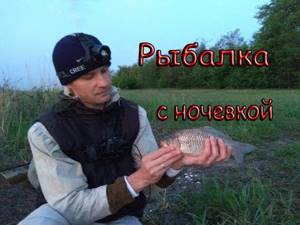
It is optimal when 5 to 10 days have passed since the end of spawning. This time is enough for crucian carp to, as fishermen say, completely “get over the disease.” That’s when the real fishing begins, when with the right approach you can catch a bucketful of crucian carp in a couple of hours. The post-spawning feeding period often occurs in early June.
If the weather is hot in June, then crucian carp will be better caught in the morning
Of course, spawning of this fish rarely occurs at the beginning of summer, but this option cannot be ruled out. Much depends on the reservoir itself, the water temperature and the inhabitants themselves. Silver crucian carp, for example, spawns together with other species - carp, tench, roach, etc. Thus, fishing may not bring the desired result - spawning and good biting are incompatible concepts.
Midsummer, July, warm and sunny outside. A great time to sit with a fishing rod on the pond and catch crucian carp. True, not everything is so simple. In July, the fish reacts sharply to the weather and does not experience such hunger as in the spring, when it regularly bites on any animal bait. A fisherman often has to work hard not to be left without a catch.
To ensure yourself a good catch of crucian carp in July, you should take a responsible approach to the choice of bait at this time of year
The optimal time for catching crucian carp is in July
Night fishing for crucian carp in the middle of summer does not bring results. The fish are actively interested in bait in the morning.
It gets light quite early in July, so fishing can start as early as 4 am. Active biting occurs from 6 to 9 o'clock.
After which rare bites are possible during the day. Of course, there are rare exceptions.
On some reservoirs, crucian carp, on the contrary, bite strictly during the day, ignoring all sorts of baits in the evening and even in the morning.
In July, fishing after 19:00 can also be productive. The sun is gradually setting towards the horizon, the heat is subsiding, and the fish are not averse to refreshment.
Often a good bite occurs from 20 to 22 hours. This is followed by complete silence.
Don’t think that catching crucian carp during the day is impossible. It’s just much more difficult, since you need to know the features of the reservoir, the parking area and the paths of movement of the fish, experiment with bait, equipment, depth, and much more.
etc.
If you are going fishing in July, it is better to choose morning or evening hours.
The influence of weather conditions: where to catch crucian carp in July
In July, the water level in rivers and lakes remains virtually unchanged; the spawning period is a thing of the past. Therefore, fishing for crucian carp at this time largely depends on the weather.
In summer there are a lot of hot and windless days. Because of this, the oxygen level in the water decreases, and the crucian carp practically stops moving through the reservoir.
It bites a little better on rivers or lakes with a slight current. After all, here the oxygen regime is much more stable.
On July days, catching crucian carp in a pond with stagnant water is quite difficult, especially when there is complete calm. In this case, you need to look for fish among the vegetation, because when swimming here, it touches tufts of grass or reeds. Therefore, small air bubbles float up from the sludge. It turns out that in such places there is a little more oxygen in the water, which has a positive effect on the bite of crucian carp.
When the air temperature exceeds 27-30°C in July, the fish tries to go deeper. Therefore, fishing with a float rod becomes less effective.
It is better to switch to long-casting gear. You can successfully fish with a float only in bushes, snags or in the shade of trees.
If there is no wind and the water is flat, then be guided by bubbles and small splashes. This is a clear sign that crucian carp are now active there.
For fishing in July, preference should be given to gear for long casting, because... due to the weather, crucian carp may go closer to the bottom
Fishing in July will definitely be successful if it’s cloudy or there’s a little rain outside. It's all about the oxygen regime again. In bad weather, the water is saturated with oxygen, prompting the crucian carp to actively search for food. Often the crazy bite begins during a thunderstorm. Whereas prolonged rains, lasting more than 2-3 hours, have a bad effect on it.
Bait
Fishing for crucian carp in July is also complicated by the fact that it is now very difficult to please the fish with bait. You need to have different types of attachments at your disposal. Of course, on a particular pond, crucian carp can feed only on worms all summer, but on another pond they can change their taste preferences during the day.
A stable and good bite in the summer occurs on dough or chatterbox. Many fishermen try to make several types of dough. It can differ both in consistency (liquid, thick, stretchy) and in taste (with the addition of honey, garlic, valerian, seeds, potatoes, etc.). By the way, it is convenient to place the batter on a hook using a syringe, where it does not dry out for a long time.
The chatterbox is perfect for summer fishing for crucian carp
A bait like pearl barley also performs well in July. You can cook it with garlic or add a little flavor afterwards.
Often at this time crucian carp bite well on bloodworms. The only problem is where to get it, because in the summer even in large fishing stores it is not always available for sale.
But you can buy canned corn everywhere. This kind of bait seems very appetizing to the fish in July.
And here's what you need to know: Carp biting forecast for 7 days.
When the weather is hot outside, many fishermen for some reason decide not to use a worm as bait. This is not entirely correct.
Firstly, crucian carp always have a need for protein. Secondly, the worm is a fairly familiar food for fish, which increases the chance of a bite. Finally, thirdly, on large lakes such bait is always effective, and you can fish with it regardless of the time of year.
Animal baits such as maggots or worms will be effective in July.
Let's summarize what has been said. Fishing for crucian carp in summer requires a large arsenal of bait. Be sure to take worms and dough with you. If you also have maggot, pearl barley, corn and bloodworms on hand, then your chances of a good bite will increase dramatically. Try different attachments. It happens that in the morning the crucian carp does not bite on the same maggot, but in the afternoon, on the contrary, it may be tempted only by this bait.
Proper bait is the secret to success in July fishing
Any complementary food can be used. We have previously discussed various options for its preparation many times. Of course, in July it is easier and better to take with you purchased mixtures that you dilute directly at the fishing site. Ask why?
The thing is that complementary food made at home can quickly deteriorate in the heat and, instead of luring the fish, it will begin to scare them away with its unpleasant odor. In addition, “homemade” complementary food always contains porridge, and crucian carp can quickly fill up on it.
This is again an argument in favor of store-bought mixtures, low-calorie and finely ground. Remember that your task is not to feed the fish, but to awaken its appetite and attract it to the fishing spot.
It is better to buy ready-made mixtures as bait for fishing in July.
When you don’t have the opportunity to use store-bought bait, you can get by with the following option. Take cake, finely crumbled black bread and millet with you when fishing.
All ingredients are mixed on the shore with water and soil (clay is also suitable). Next, form the bait balls.
First, throw a couple of them into the water and start fishing. In summer, it is important not to saturate the fish with bait, so feed in small portions with an interval of 2-3 hours.
May has ended, the most important month in life for the inhabitant of almost all ponds, lakes and rivers - crucian carp. Summer is coming - the time to restore strength after spawning and gain weight for the next winter.
But many fishermen complain that fishing for crucian carp in June is unpromising; even the saying “June is a waste of time for fishing” was supposedly invented because of our pickiness. Let's understand the features of summer crucian carp fishing.
Picky parking spots
Let's try to find crucian carp in different summer months, to do this we will analyze its habits and characteristics of life in different periods. Our division by month is arbitrary, because in different regions of a huge country the climate is also heterogeneous. Rather, it characterizes the weather conditions on the reservoir.
Good day to you, dear friends. In today's article I decided to touch on the topic of catching crucian carp in July. The second month of summer is the most favorable for catching crucian carp, however, many anglers often leave the reservoir with nothing.
As everyone knows, crucian carp is a rather capricious fish, and catching it at any time of the year is unpredictable. So, let's figure out what are the features of catching this fish in the middle of summer, and how not to be left without a catch.
The best time to catch crucian carp is in the morning. Its biting begins at 4 o'clock in the morning, but reaches its peak at 6-7 o'clock, and by 9 o'clock it practically stops.
Fishing for crucian carp in the evening is less effective, but if you are patient, you will definitely not be left without a catch. In the evening, crucian carp begin to bite from the moment the sun stops illuminating the pond.
This happens at about 20:00, by 21:00 the bite reaches its peak, and already at 22-23:00 it stops completely. At night the crucian carp does not bite.
From 9 am, the crucian carp changes its parking places, moving closer to the middle of the reservoir. However, crucian carp have short periods when they approach the shore. Day is the most difficult time for fishing.
If you know the peculiarities of the movement of crucian carp in a reservoir, and understand the reasons for these movements, then even during the day you will catch no worse than in the morning, and read about these features below.
Fishermen have noticed that in rainy weather the fish go deeper. Therefore, you should not catch it in shallow water. It is advisable to do this in wide areas and throw the tackle into the riverbed area and near holes. If fishing is carried out with donks and feeders, then the bites are not frequent, but more confident. Crucian carp, bream, roach, and silver bream lay the bait so that the hook is retrieved by the extractor.
Usually in the summer before precipitation, bites are rare. But after a good rain, a great catch is expected. This is due to the addition of oxygen, which has a revitalizing effect on underwater inhabitants. The presence or absence of wind is important. If there are waves, then fishing will be unpromising.
Peaceful fish move to the shore when it rains. Therefore, it is advisable to catch it on the first edge or in the coastal area. It is better to use a float near the coastal dump behind the reeds, if there is no strong wind. For crucian carp, roach, and bream, it is better to use worms, maggots, bloodworms, and pearl barley. It is better not to fish during a thunderstorm. Fishing rods conduct current, so being on the shore is dangerous.
If you are fishing during the rain, then you should not be surprised if the water becomes cloudy. If the cloudiness of the water is slight, then the bite becomes better than in clear water, but if the cloudiness of the water is strong, then the fish bites worse.
Much depends on which body of water you choose. Small ponds and muddy streams instantly become cloudy under the influence of rainwater, and it will become clear after only a few days.
This means that if the weather forecast predicts rain, then it is more rational to go to a natural lake and deep reservoir.
The peculiarity of fishing in the rain is that the percentage of false bites is incredibly small. Trying to grab the tempting bait, the fish will swallow it almost entirely.
Large fish such as bream are often caught. Particularly active biting can be observed during high tide.
Wave height plays a significant role when fishing in the rain. If the waves are too big, it will be difficult for the fish in the depths to catch the bait, so the bite will subside.
In addition, if the wind is also blowing from the north or east, then you can go home without a shadow of a doubt - there will be no bite.
Fishing in rainy weather is best in warm weather, when there is no piercing cold, and the fish are active during this period. The best conditions will be a light warm rain with a slight south or west wind. It’s also nice to fish after a short downpour, when the sun is peeking out of the clouds.
Fishing in the rain usually produces good results! Moreover, not only a lot of fish are caught, but they are also large in size.
